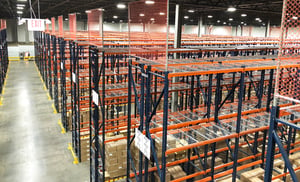 Efficient storage and organization are crucial components of a well-run facility, whether it's a warehouse, distribution center, or manufacturing plant. One of the key elements in achieving optimal efficiency is the implementation of a well-designed racking system. Racking systems provide a structured and organized way to store goods, materials, and products, maximizing both space and accessibility.
Efficient storage and organization are crucial components of a well-run facility, whether it's a warehouse, distribution center, or manufacturing plant. One of the key elements in achieving optimal efficiency is the implementation of a well-designed racking system. Racking systems provide a structured and organized way to store goods, materials, and products, maximizing both space and accessibility.
Let’s explore a few strategies to help you get the most out of your racking system and enhance the overall productivity of your facility.
Customized Design: Tailoring to Your Needs
The first step in optimizing your racking system is to ensure that it is tailored to the specific needs and constraints of your facility. Every operation is unique, and a one-size-fits-all approach may not be the most effective. Consider the size, weight, and dimensions of your inventory, as well as the layout of your facility. Customizing the design of your racking system will allow you to maximize the use of available space and streamline your workflow.
Vertical Space Utilization: Going Up
Many facilities underutilize vertical space, focusing only on floor-level storage. Investing in taller racking systems allows you to take advantage of vertical space, making the most of the cubic footage in your facility. This not only increases storage capacity but also promotes better organization and accessibility. Utilizing vertical space effectively is particularly beneficial in settings where floor space is limited.
Inventory Classification: A Place for Everything
Organizing your inventory is essential for a streamlined operation. Implement a classification system based on the frequency of use, size, and other relevant factors. Assign specific rack locations for different categories of items, making it easier for employees to locate and retrieve products quickly. This reduces the time spent searching for items, ultimately increasing overall efficiency. It may be advantageous to explore pick to light, put to light, and voice picking technologies.
Implement FIFO and LIFO: Streamlining Operations
Depending on the nature of your inventory, implementing either the First-In-First-Out (FIFO) or Last-In-First-Out (LIFO) strategy can significantly improve efficiency. FIFO is ideal for perishable goods, ensuring that older items are used first. LIFO, on the other hand, may be more suitable for non-perishable goods. Tailoring your racking system to support these strategies will help streamline your operations and reduce the risk of inventory obsolescence.
Regular Maintenance: Ensuring Longevity
To get the most out of your racking system in the long run, it's crucial to prioritize regular maintenance. Regular inspections can identify any potential issues, such as damaged components or misalignments, before they escalate. Implementing a proactive maintenance schedule ensures that your racking system remains in optimal condition, maximizing its lifespan and preventing unexpected downtime.
A well-designed and thoughtfully implemented racking system is a cornerstone of a successful and efficient facility. By customizing the design, utilizing vertical space, implementing effective inventory classification, and adopting strategies like FIFO and LIFO, you can optimize your racking system to meet the specific needs of your operation. Regular maintenance is the key to ensuring the longevity of your system and sustaining its efficiency over time. Investing time and resources into these strategies will not only improve productivity but also contribute to the overall success of your facility.
Author: Heather Connors, Director of Marketing, CHC

